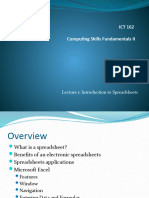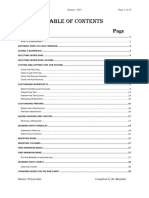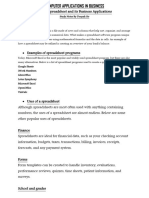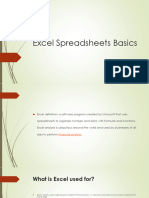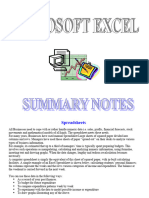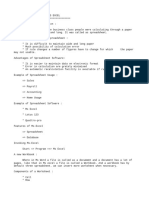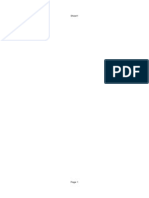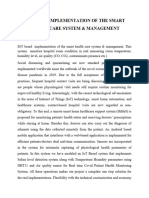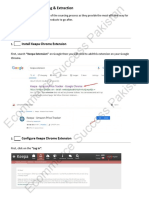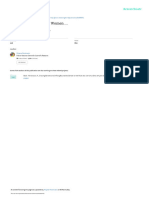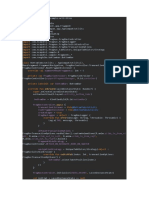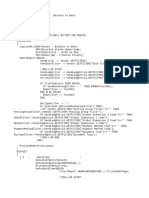Table of Contents
1 Spreadsheet..............................................................................................................................................1
1.1 An Overview......................................................................................................................................1
1.2 Features of Spreadsheet....................................................................................................................1
1.3 Applications of Spreadsheet..............................................................................................................3
2 Creating and Renaming Workbook...........................................................................................................4
2.1 Creating A Workbook........................................................................................................................4
2.2 Saving A Workbook............................................................................................................................5
2.3 Opening A Workbook........................................................................................................................6
3 Using WORKSHEETS..................................................................................................................................7
3.1 Renaming A Worksheet.....................................................................................................................7
3.2 Adding A Worksheet..........................................................................................................................8
4 Formatting Worksheets............................................................................................................................9
4.1 To Format Text in Bold or Italics:.....................................................................................................9
4.2 To Format Text as Underlined:..........................................................................................................9
4.3 To Change the Font Style:.................................................................................................................9
4.4 To Change the Font Size:.................................................................................................................10
4.5 To Change the Text Color:..............................................................................................................10
4.6 To Add a Border:.............................................................................................................................10
4.7 To Add a Fill Color:........................................................................................................................10
5 Formula..................................................................................................................................................11
5.1 Arithmetic Operators.......................................................................................................................11
5.2 Logic Formula.................................................................................................................................12
6 Printing Worksheets...............................................................................................................................13
6.1 Printing Setup..................................................................................................................................13
6.2 Using Print Ranges..........................................................................................................................13
Reference..................................................................................................................................................16
0
�1 Spreadsheet
1.1 An Overview
A spreadsheet is a document that stores data in a grid of horizontal rows and vertical columns.
Spreadsheets are primarily used to work with numbers and text. A spreadsheet is divided into a
series of rows and columns to store the information. Rows are typically labeled using numbers
(1, 2, 3, etc.), while columns are labeled with letters (A, B, C, etc.). Individual row/column
locations, such as C3 or B12, are referred to as cells. In a spreadsheet application, each value sits
in a cell. The relationships between cells are called formulas, and the names of the cells are
called labels. Once you have defined the cells and the formulas for linking them together, you
can enter your data. You can then modify selected values to see how all the other values change
accordingly. Most spreadsheet applications are multidimensional, meaning that you can link one
spreadsheet to another. A three-dimensional spreadsheet, for example, is like a stack of
spreadsheets all connected by formulas. A change made in one spreadsheet automatically affects
other spreadsheets.
1.2 Features of Spreadsheet
Spreadsheet software provides all the features you need to create a professional looking spreadsheet.
Some of the main features of a spreadsheet program are:
It provides a standard grid, which may be scrolled and zoomed. Text, numeric or date values or
formulas may be entered into the selected cell through the formula bar at the top of the screen.
Cells may be formatted using the format pages, which let you specify the font style, borders, text
and background colors, the size of cells and text alignment within the cells.
1
� Spreadsheet provides support for multiple sheets within a workbook. When you press the
worksheet button, worksheets are presented in a horizontally scrollable page, allowing you to
quickly flick between all the worksheets in the workbook.
A worksheet may be selected simply by tapping on it. You can create new worksheets and delete
or rename existing worksheets.
Spreadsheet provides the ability to search the worksheet for any phrase, number or other text,
letting you easily scroll between search results. It is also possible to sort a range of cells by any
row or column.
Spreadsheet supports a variety of functions used to perform basic calculations based on
parameters set by the user.
Spreadsheets can be integrated for use with other software programs. One example is a mail
merge. A spreadsheet can be created with the names and addresses of various individuals, and a
mail merge can be used to fill in text boxes into form letters.
Data in spreadsheets can be displayed in a graphic form. Spreadsheets allow the numerical data in
the cells to be displayed as a graph or chart.
Fig no 1 (Spreadsheet)
2
�1.3 Applications of Spreadsheet
Some of the applications of a spreadsheet program are as under:
A spreadsheet allows users to enter and calculate numerical data.
Using a spreadsheet greatly increases productivity for anyone who needs to manage receipts,
create budgets, generate financial reports or even keep track of inventories.
A spreadsheet is a useful tool for sorting and analyzing data.
Complex calculations can be performed very quickly.
Professional looking graphs and charts can be created very quickly from a range of data which
allows you to view the data pictorially.
Easy to make changes and corrections to data on the worksheet. Calculation is always accurate,
provided that data and formulae entered are correct.
3
�2 Creating and Renaming Workbook
2.1 Creating A Workbook
Excel files are called workbooks. Each workbook holds one or more worksheets (also known as
spreadsheets). To Create a New Workbook:
Click the File tab to move on backstage view.
Select New.
Select Blank workbook under Available Templates. (It will be highlighted by default.)
Click Create. A new blank workbook appears in the Excel window.
Fig no 2 (Create)
4
�2.2 Saving A Workbook
Once you are done with typing in your new excel sheet, it is time to save your sheet/workbook to avoid
losing work you have done on an Excel sheet. To Save the Workbook:
Click the File tab and select Save or Save As option.
Save as allows you to name the file and choose a location to save the spreadsheet. Choose Save
As if you would like to save the file for the first time or if you would like to save the file as a
different name.
Select save if the file has already been named.
Fig no 3 (Saving)
5
�2.3 Opening A Workbook
There may be a situation when you open an existing workbook and edit it partially or completely. To
Open an Existing Workbook:
Click the File tab to move on backstage view.
Select Open. The Open dialog box appears
Select a folder where you would like to save the sheet, Enter file name which you want to give to
your sheet and Select a Save as type, by default it is .xlsx format.
Finally, click on Save button and your sheet will be saved with the entered name in the selected
folder
6
� Fig no 4 Saving
3 Using WORKSHEETS
In a workbook, the tabs displayed at the bottom of the screen are named Sheet1, Sheet2 and
Sheet3. These are not very informative names. Excel allows you to define a meaningful name for
each worksheet in a workbook so that you can quickly locate information.
3.1 Renaming A Worksheet
To Rename a Worksheet:
7
� Double-click the sheet tab to select it. The text is highlighted by a black box.
Fig no 5 (Renaming)
Right click on the sheet tab and select Rename option from the shortcut menu. The text is
highlighted by a black box.
Type a new name for the worksheet.
3.2 Adding A Worksheet
By default, each new workbook in Excel defaults to three worksheets named Sheet1, Sheet2 and Sheet3.
You have the ability to insert new worksheets if needed.
To Insert a New Worksheet:
To quickly insert a new worksheet at the end of the existing worksheets, click the Insert
Worksheet tab at the bottom of the screen
8
�Fig no 5 Adding sheet
To insert a new worksheet in front of an existing worksheet, select that worksheet and then, on
the Home tab, in the Cells group, click Insert, and then click Insert Sheet.
Right click on the sheet tab and select Insert option from the shortcut menu
Fig 6 (adding work sheet)
4 Formatting Worksheets
Once you have entered information into a worksheet, you will need to be able to format it.
4.1 To Format Text in Bold or Italics:
Left-click a cell to select it or drag your cursor over the text in the formula bar to select it.
Click the Bold or Italics command.
9
� Fig no 7 (Format Text)
4.2 To Format Text as Underlined:
Select the cell or cells you want to format.
Click the drop-down arrow next to the Underline command.
Select the Single Underline or Double Underline option
4.3 To Change the Font Style:
Select the cell or cells you want to format.
Left-click the drop-down arrow next to the Font Style
box on the Home tab.
Select a font style from the list.
4.4 To Change the Font Size:
Select the cell or cells you want to format.
Left-click the drop-down arrow next to the Font Size box on the Home tab.
Select a font size from the list
4.5 To Change the Text Color:
Select the cell or cells you want to format.
Left-click the drop-down arrow next to the
Text Color command.
10
� A color palette will appear.
Select a color from the palette
Select More Colors. A dialog box will appear.
Select a color.
Click OK.
4.6 To Add a Border:
Select the cell or cells you want to format.
Click the drop-down arrow next to the Borders
command on the Home tab.
A menu will appear with border options.
Left-click an option from the list to select it.
4.7 To Add a Fill Color:
Select the cell or cells you want to format.
Click the Fill command. A color palette will appear.
Select a color
5 Formula
Formulas are equations that perform calculations on data values in the worksheet. Like a
calculator, Excel can execute formulas that add, subtract, multiply, and divide. A formula can be
a combination of constant values, cell references and mathematical operators (+, -, /, *, =).
A formula starts with an equal sign (=) in a cell. This tells Excel that you are entering a formula,
not just numbers.
Type the equation you want to calculate. For example, to add up 10 and 20, you type =10+20.
Press the Enter key to complete your calculation.
11
� Instead of entering numbers directly in your calculation formula, you can put them in separate
cells, and then reference those cells in your formula, e.g., =A1+A2+A3.
Example: The following formula multiplies 5 by 10 and then adds the value in cell A2 to the result:
=A2+5*10
5.1 Arithmetic Operators
Operator Description Excel Formula
+ (Addition Operator) It makes the addition of two or more than two numeric values and = A1 + B1
gives a numeric value as a return.
–(Subtraction Subtracts two or more than two numeric values and gives a numeric = A1 – B1
Operator) value in return
*(Multiplication Multiplies one numeric value with the other and gives a numeric = A1 * B1
Operator) value in return
/ (Division Operator) Divides the numerator (should be numeric) value with the = A1 / B2
denominator (should be numeric) value and gives a numeric value
in return.
%(Percentage Converts the number present in a cell into a percentage (i.e., divides = A1 %
Operator) the number by 100)
5.2 Logic Formula
Operator Description Excel Formula
= (Equals To) It compares two values and returns TRUE if both values are equal; =A1 = B1
12
� else returns FALSE.
<> (Not Equals To) It compares two values and returns TRUE if both values are not equal =A1 <> B1
to each other else returns FALSE.
> (Greater Than) It returns TRUE if the value in cell A1 (First Value) is greater than =A1 > B1
the value in cell B1 (Second Value) else returns FALSE.
< (Less Than) It returns TRUE if the value in cell A1 (First Value) is lesser than the =A1 < B1
value in cell B1 (Second Value); else returns FALSE.
>= (Greater than or It returns TRUE if the value in cell A1 (First Value) is greater than or =A1 >= B1
equals to) equals to the value in cell B1 (Second Value); else returns FALSE.
6 Printing Worksheets
6.1 Printing Setup
Printing in Excel is much like printing in other Office applications like Microsoft Word.
By default, Excel prints the entire worksheet. Print Preview is a method to review the formatting and
make sure the columns, rows, and margins appear exactly as you want them.
Excel allows you to print all or part of a worksheet or workbook, with just the information you need.
To View the Print pane:
Click the File tab. This takes you to Backstage view.
13
� Select Print. The Print pane appears, with the print settings on the left and Print Preview on the
right.
Fig no Printing
6.2 Using Print Ranges
By default, Excel prints the whole worksheet.
Sometimes, you only need to print some specific ranges instead of the whole worksheet for
saving paper and printer ink.
This section will talk about how to print multiple cell ranges in Microsoft Excel.
To Print a Worksheet:
Select the worksheets that you want to print.
To print multiple worksheets, click the first worksheet, hold down the Ctrl key, then click
the other worksheets you want to select.
Click File, and then click Print.
OR
Press Ctrl+P. The Print pane window appears.
Click the Print button. To Print Active sheet:
A worksheet is considered active if it is selected.
Select the worksheets you want to print.
Click the File tab Print to access the Print pane.
Select Print Active Sheets from the print range drop-down menu.
14
� Click the Print button. To Print the Entire Workbook:
Click the File tab Print to access the Print pane.
Select Print Entire Workbook from the print range drop-down menu.
Click the Print button. To Print a Selection:
Select the cells you want to print.
Click the File tab Print to access the Print pane.
Select Print Selection from the print range drop-down menu.
You can see what your selection will look like on the page in Print Preview.
Click the Print button. To Print only Selected Cell Ranges:
Hold down the Ctrl key to select the non-contiguous ranges or cells.
Click Page Layout tab Page Setup group Print Area command. From the drop down
list, select Set Print Area.
15
� The selected ranges will be surrounded by a dotted line. Click File Print to start printing the
ranges one by one.
16
�Reference
1) https://www.techtarget.com/whatis/definition/spreadsheet
2) https://www.epa.gov/sites/default/files/2015-06/documents/UsingExcelREV.pdf
3) https://www.scribd.com/document/545785025/343425371-a-Project-Report-On
4) https://www.scribd.com/document/706678299/excel-report
5) https://en.wikipedia.org/wiki/Spreadsheet
17


